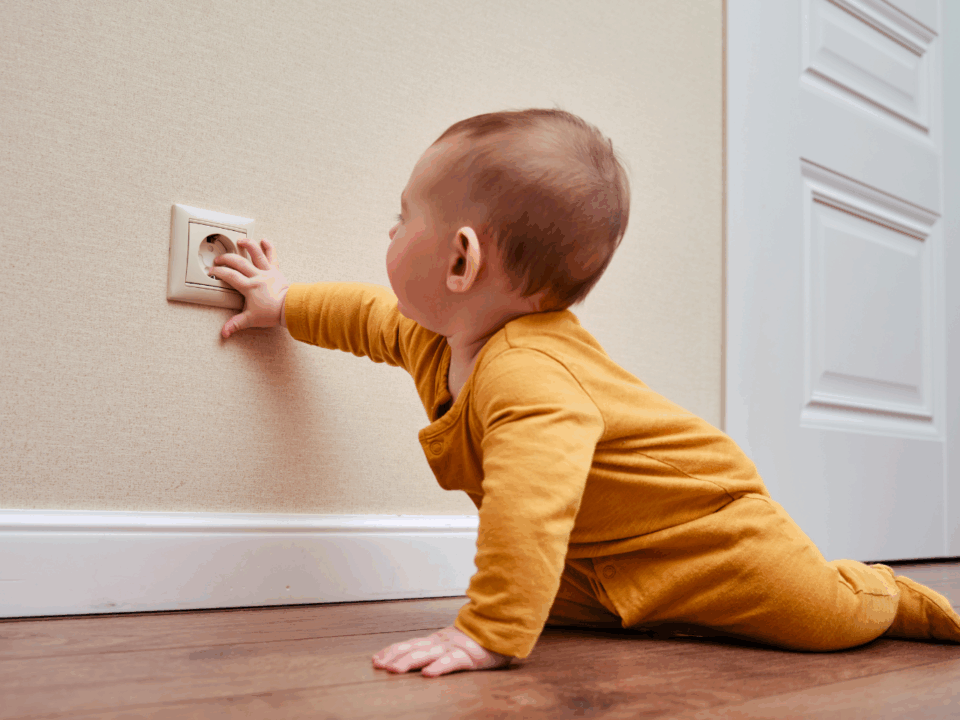Babies grow fast—and so do their needs for safety. What’s perfectly fine one month can become a hazard the next. Now is the perfect time to double-check your home and routines. Whether you’re expecting your first baby or chasing a speedy crawler, this stage-by-stage guide will help you feel more prepared (and a little less overwhelmed).
Before Baby Arrives: Set the Stage
The best time to think about baby safety is before your little one arrives. It’s much easier to anchor a dresser or install outlet covers when you’re not juggling feedings and diaper changes. Laying the groundwork now gives you peace of mind and helps you focus on bonding once baby comes home.
■ Install safety gear early: Anchor furniture, secure TVs, and install window guards and outlet covers before the baby is mobile. Time flies and you’ll be there before you know it!
■ Practice safe sleep prep: Choose a crib that meets current safety standards. No bumpers, blankets, or stuffed animals—just a fitted sheet.
■ Review product recalls: Register baby items and check the Consumer Product Safety Commission website for up-to-date recalls.
Newborn Stage (0–3 Months): All About Sleep & Snuggles
Newborns sleep a lot, and sleep safety is critical in these early months. Your baby isn’t mobile yet, but that doesn’t mean your job is easy. Small choices like how you dress them or where they sleep can make a big difference in keeping your baby safe and cozy.
■ Safe sleep matters: Always place baby on their back to sleep, on a firm, flat surface like a crib or bassinet.
■ Car seat check: Make sure your infant car seat is installed correctly. Many fire stations, police stations, and hospitals offer free checks.
■ Avoid overheating: Dress baby in one more layer than you would wear and skip thick blankets.
Infant Stage (3–6 Months): Reaching & Rolling
Your little one is starting to move—maybe rolling, grabbing, or sitting with support. That curiosity leads to new risks. It’s time to reassess your surroundings and stay a step ahead of their growing mobility and curiosity.
■ Keep small objects out of reach: Anything that fits through a toilet paper roll is a choking hazard.
■ Update floor safety: Babies will soon start rolling! Keep floors clean and clear of hazards like coins, batteries, or small toys from older siblings.
■ Check baby gear weight limits: Swings, bouncers, and carriers all have age and weight guidelines—don’t exceed them.
Mobile Baby (6–12 Months): Crawlers & Cruisers
Once your baby is on the move, everything becomes fair game. Crawlers love cords, cabinets, and anything they can pull up on. Creating safe zones and being consistent with boundaries helps your baby explore while keeping risks low.
■ Babyproof at their level: Get on your hands and knees to spot sharp corners, cords, and breakables within reach.
■ Lock it up: Use cabinet locks for anything with cleaning products, medicine, or sharp tools.
■ Gate it off: Use baby gates at the top and bottom of stairs and block off rooms you don’t want baby entering solo.
Toddling & Beyond (12 Months+)
With a little more independence comes new safety concerns. Toddlers are climbers, explorers, and fast movers, so your job becomes anticipating risks and teaching basic safety skills along the way.
■ Strap it down: Secure dressers, bookshelves, and other climbable furniture to the wall to prevent tip-overs.
■ Watch for water: Drowning can happen in just inches of water—never leave a toddler unattended near tubs, toilets, or buckets. Also, make sure pools are fenced in and secured. Empty kiddie pools and water play areas.
■Keep exploring safe: Teach basic safety like staying away from ovens, not touching outlets, and gentle pet interaction.
Bonus Safety Tips for All Ages
No matter how old your baby is, a few safety strategies apply across the board. Having a plan, staying calm, and trusting your instincts can help you respond to the unexpected with confidence.
■ Know emergency numbers: Have pediatrician, poison control, and emergency contacts saved in your phone and posted somewhere visible.
■ Take an infant CPR class: This can be life-saving knowledge—and help you feel more confident.
■ Trust your gut: If something feels off, ask questions, call your pediatrician, or get a second opinion.





